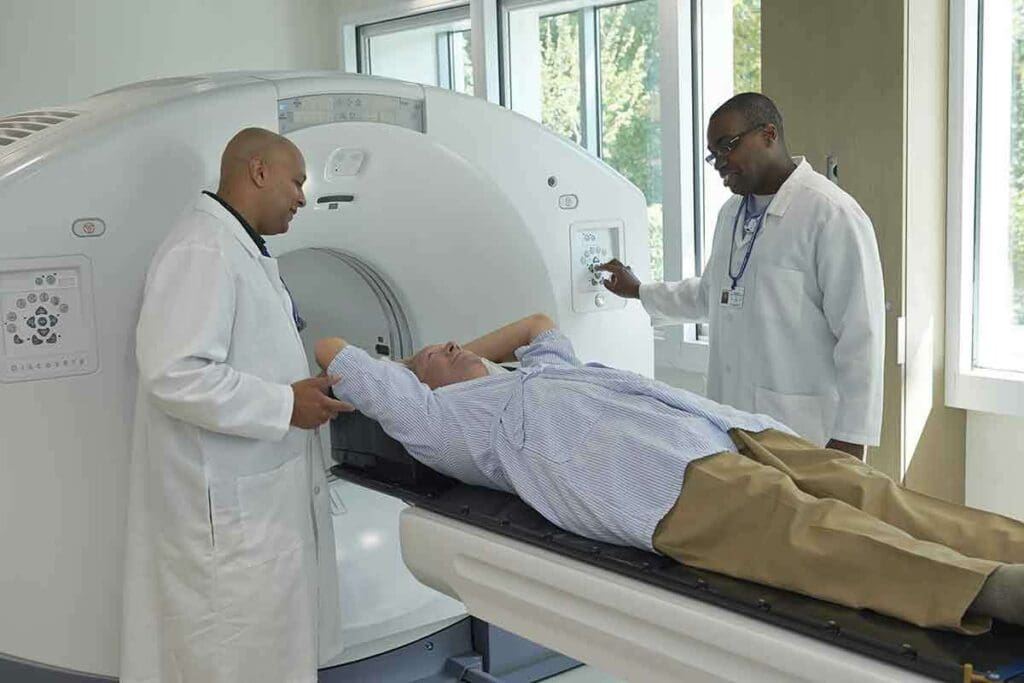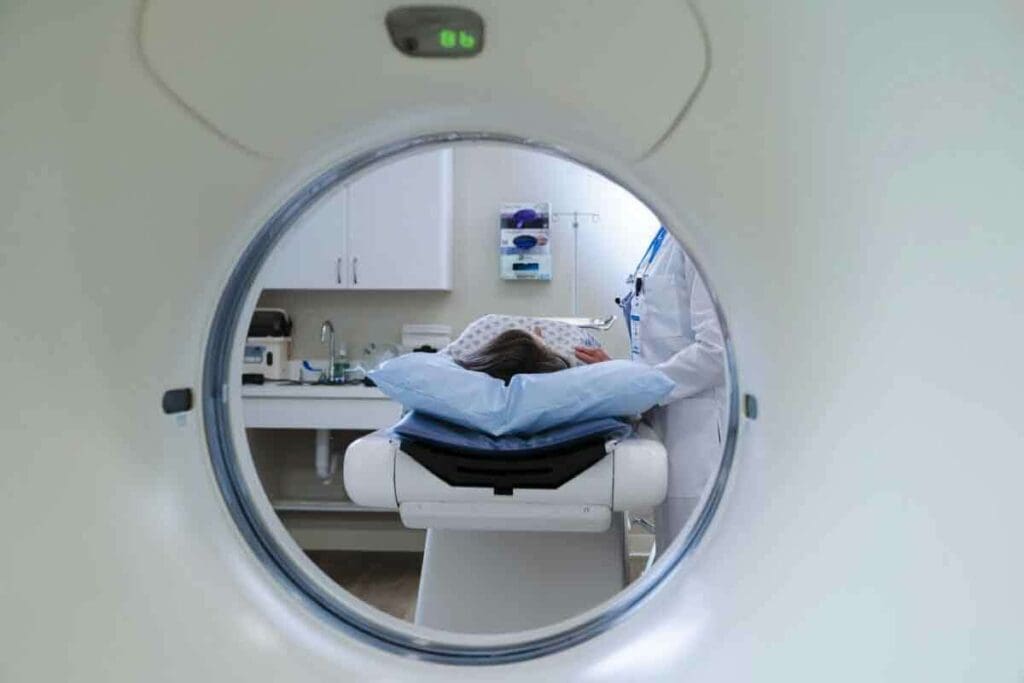Last Updated on November 27, 2025 by Bilal Hasdemir

External Beam Radiation Therapy (EBRT) is a common treatment for various types of cancer. It involves directing a beam of radiation from outside the body to target and destroy cancer cells.
The duration of radiation treatments varies based on the type of cancer, treatment goals, and individual patient needs. Typically, patients receive daily radiation therapy sessions, Monday through Friday, for a period of 5 to 8 weeks.
Liv Hospital’s expert team delivers EBRT with precision, safety, and compassion. They support patients with personalized care and innovative protocols. Discover how Long Do Radiation Treatments Really Last? and what factors affect session frequency.
Key Takeaways
- External Beam Radiation Therapy is a common cancer treatment.
- Treatment duration varies based on cancer type and treatment goals.
- Patients typically receive daily radiation sessions for 5 to 8 weeks.
- Liv Hospital’s team provides personalized care and innovative protocols.
- EBRT is delivered with precision, safety, and compassion.
Understanding External Beam Radiation Therapy (EBRT)

External Beam Radiation Therapy (EBRT) is a common cancer treatment. It uses beams of radiation from outside the body to kill cancer cells. This method is key in fighting cancer, helping to shrink tumors and ease symptoms without surgery.
What Is External Radiotherapy?
External radiotherapy, or EBRT, uses a machine to send radiation beams at tumors. These beams can be photons, electrons, or protons, each for different tumors. This depends on the tumor’s depth and location in the body.
First, doctors plan carefully to aim the beams right at the tumor. This keeps healthy tissue safe. This planning is key to the treatment’s success.
How EBRT Differs from Other Radiation Treatments
EBRT is different from internal radiation therapy (brachytherapy), where radiation is placed inside the body. EBRT treats bigger areas and is less invasive.
The table below shows the main differences between EBRT and brachytherapy:
| Characteristics | External Beam Radiation Therapy (EBRT) | Brachytherapy |
| Radiation Source Location | Outside the body | Inside the body, near the tumor |
| Treatment Area | Can treat larger areas | Limited to the area around the radiation source |
| Invasiveness | Non-invasive | Involves placing a radiation source inside the body |
It’s important for patients to know about EBRT and its differences from other radiation therapies. EBRT uses advanced technology and precise targeting. It’s a powerful tool for many cancer patients.
The Technology Behind External Radiation Therapy

At the heart of EBRT lies a complex technology. It enables the precise delivery of radiation beams to cancerous cells. This technology is key to treating tumors effectively while protecting healthy tissue.
Linear Accelerators and Radiation Beams
Linear accelerators are the core of EBRT. They generate high-energy radiotherapy beams aimed at tumors. These machines speed up electrons to produce X-rays or gamma rays, shaped to fit the tumor’s shape.
The precision of linear accelerators allows for high doses of radiation to tumors. This is done while protecting healthy tissue. Sophisticated control systems ensure the accurate delivery of beam radiation.
Targeting Tumors While Sparing Healthy Tissue
One big challenge in EBRT is hitting tumors without harming healthy tissue. New technology has led to techniques like Intensity-Modulated Radiation Therapy (IMRT) and Image-Guided Radiation Therapy (IGRT). These improve the precision of external radiation therapy.
IMRT changes the intensity of radiation beams in small areas. This allows for a closer match to the tumor’s shape. IGRT uses imaging to guide the radiation, ensuring it hits the right spot.
Recent Technological Advances in EBRT
Recently, EBRT technology has seen big improvements. New linear accelerators and imaging techniques have been developed. These advancements have made EBRT more accurate and effective, leading to better treatment results.
Techniques like Stereotactic Body Radiation Therapy (SBRT) and Volumetric Modulated Arc Therapy (VMAT) have also improved EBRT. These technologies keep getting better, opening up new ways to fight cancer.
How Long Do Radiation Treatments Last: Session Duration
The time it takes for a radiation treatment can vary. Knowing what to expect can help ease anxiety for patients. A typical session involves more than just the radiation itself.
Typical Length of a Single Treatment Session
A single radiation treatment session usually lasts between 15 and 45 minutes. This time includes patient positioning, imaging, and the actual radiation delivery.
Preparation Time vs. Actual Radiation Beam Delivery
While the whole session may last up to 45 minutes, the actual radiation delivery takes less than five minutes. Most of the time is spent on preparation. This includes positioning the patient correctly and verifying the target area using imaging technologies.
Factors That May Extend Session Duration
Several factors can make a radiation treatment session longer. These include:
- The complexity of the treatment plan
- The need for additional imaging or verification
- Any unexpected issues during patient positioning
- The use of advanced techniques that require more time for delivery
Understanding these factors can help patients better prepare for their treatment sessions. It can also help manage their expectations about the time needed for each session.
Treatment Frequency: How Often Do You Get Radiation Treatments?
Knowing how often you get radiation treatments is key for those getting external beam radiation therapy. The schedule is made to make the therapy work best while letting healthy cells heal.
Standard Treatment Schedule
Most people get radiation treatments every day, from Monday to Friday. This schedule lets radiation be given daily while healthy cells rest on weekends. As a radiation oncologist, he says, “The weekday schedule helps in optimizing the therapeutic ratio by allowing normal tissues to repair themselves over the weekend.”
The treatment schedule aims to balance giving radiation and letting the body heal. “The standard fractionation schedule has been developed to maximize tumor control while minimizing damage to surrounding healthy tissues,” a study in the Journal of Clinical Oncology found.
Why Treatments Are Typically Given on Weekdays
Treatments are given on weekdays for both practical and scientific reasons. Logistically, it’s easier to plan and staff on weekdays. Scientifically, a daily dose helps predict how both tumors and healthy tissues will react.
- Consistency in treatment delivery
- Optimal use of resources and personnel
- Enhanced therapeutic ratio due to normal tissue recovery
Weekend Breaks and Their Importance
The weekend break is a key part of the treatment schedule. It lets damaged normal cells heal, which lowers the chance of lasting side effects.
“The weekend reprieve from radiation exposure gives normal tissues a chance to recover, which is essential for maintaining the quality of life for patients,” supported by years of research.
In summary, the timing of radiation treatments is planned carefully for the best results. Knowing the standard schedule helps patients get ready for treatment.
Overall Treatment Timeline for Beam Radiation Therapy
Knowing the treatment timeline for beam radiation therapy is key for patients. It helps them plan their care well. The time needed can change a lot. This depends on the cancer type, its stage, and the patient’s health.
Standard 5-8 Week Treatment Courses
Most patients get a standard beam of radiation therapy that lasts 5 to 8 weeks. They get treated daily, from Monday to Friday, with weekends off. The exact time needed depends on the cancer type and treatment goals.
Standard Treatment Schedule
| Treatment Type | Typical Duration | Frequency |
| Standard EBRT | 5-8 weeks | Daily, Mon-Fri |
| Hypofractionation | 1-3 weeks | Less frequent, as prescribed |
| Stereotactic Radiosurgery | 1 session | Single session |
Shortened Treatment Regimens (Hypofractionation)
For some, a shorter treatment called hypofractionation is used. It gives higher doses of radiation in 1 to 3 weeks. This is often for certain tumors or for those far from treatment centers.
Single-Session Treatments (Stereotactic Radiosurgery)
For small, well-defined tumors, stereotactic radiosurgery (SRS) is used. It gives a precise, high dose of radiation in one session. This is good for tumors in sensitive areas or for those who can’t handle long treatments.
The choice between standard, hypofractionation, and SRS depends on many factors. These include the tumor’s type, size, and location, and the patient’s health and wishes. Knowing these options and their effects is vital for making the right care choices.
How Cancer Type Affects Radiation Treatment Duration
The time needed for radiation treatment changes a lot based on the cancer type. Each cancer has its own traits that affect how long and how often treatment is given. Knowing these differences helps patients get ready for their treatment.
Breast Cancer Radiation Protocols
For breast cancer, radiation is often given after surgery to kill any cancer cells left behind. The treatment for breast cancer usually lasts from 3 to 6 weeks. It happens every day, Monday through Friday. Accelerated partial breast irradiation (APBI) is a method that targets a smaller area. It can make treatment shorter, lasting only 1-2 weeks.
Prostate Cancer Radiation Timelines
Prostate cancer treatment time can vary. It depends on the cancer’s stage and how aggressive it is. Standard treatment, called external beam radiation therapy (EBRT), usually takes 7 to 9 weeks. But, newer methods like hypofractionated radiation therapy can make treatment shorter, lasting 5-6 weeks or less.
Lung Cancer Radiation Schedules
Lung cancer treatment plans change based on the tumor’s stage and where it is. For early-stage lung cancer, stereotactic body radiation therapy (SBRT) is often used. It can be done in just 3-5 fractions over 1-2 weeks. For more advanced cases, conventional radiation therapy is used, lasting 6-7 weeks.
Brain Tumor Radiation Approaches
Brain tumor treatment varies by the tumor’s type, grade, and location. Some brain tumors get whole-brain radiation therapy, lasting 2-3 weeks. More precise methods like stereotactic radiosurgery (SRS) can treat in one session or a few fractions. This helps avoid harming healthy brain tissue.
| Cancer Type | Typical Treatment Duration | Common Radiation Techniques |
| Breast Cancer | 3-6 weeks | Whole breast irradiation, APBI |
| Prostate Cancer | 7-9 weeks | EBRT, Hypofractionation |
| Lung Cancer | 1-2 weeks (SBRT), 6-7 weeks (conventional) | SBRT, Conventional RT |
| Brain Tumors | 2-3 weeks (whole-brain), 1-5 fractions (SRS) | Whole-brain RT, SRS |
Knowing the details of radiation treatment for different cancers helps patients prepare better. It’s key to talk to a radiation oncologist to find the best treatment plan for each person.
Pinpoint Radiation Treatment: Precision and Duration
Pinpoint radiation treatment, like stereotactic radiosurgery, has changed radiation oncology. It’s precise and can last from a few minutes to hours. This therapy targets small tumors or parts of larger ones with high accuracy.
What Makes Pinpoint Radiation Different
Pinpoint radiation is special because it focuses on specific areas. It uses advanced imaging and planning. This makes it very effective with little harm to healthy tissue.
This precision is great for tumors near important areas or that can’t be removed. Stereotactic radiosurgery (SRS) and stereotactic body radiation therapy (SBRT) are examples. They’ve shown to be very successful in fighting cancer.
Treatment Planning for Precision Radiation
Planning for pinpoint radiation involves a team of experts. They include radiation oncologists, medical physicists, and radiologists. The process starts with detailed scans like CT scans, MRIs, or PET scans to find and measure the tumor.
With special software, the team makes a detailed plan. This plan aims to give the tumor the right dose while protecting healthy areas. The plan’s accuracy is key to the treatment’s success.
Session Length for High-Precision Treatments
The time needed for pinpoint radiation can vary. It depends on the treatment’s complexity and the method used. For instance, SRS treatments might take just a few minutes to several hours.
SBRT treatments might need one to five sessions. Each session is planned to hit the target area exactly. This makes the treatment shorter than traditional radiation therapy, which is good for patients with tight schedules.
How Many Rounds of Radiation Is Normal?
Knowing how many rounds of radiation therapy are normal is key for patients. The number depends on the cancer type and treatment plan.
Can You Get Radiation Treatment More Than Once?
Yes, getting radiation treatment more than once is possible. The choice to do so depends on several factors. These include the cancer type, its stage, and the patient’s health.
Multiple radiation courses might be needed if cancer comes back or if a new cancer appears. The doctor will check if more radiation is safe and effective.
Safety Considerations for Multiple Radiation Courses
When it comes to multiple radiation courses, safety is top priority. There’s a limit to how much radiation a patient can safely get. Getting too much can lead to serious side effects.
Radiation oncologists plan and watch each treatment closely. They check the total radiation dose to healthy tissues and organs. They also see how the tumor reacts to previous treatments.
| Factors | Description | Considerations |
| Cancer Type and Stage | The type and stage of cancer influence the number of radiation treatment rounds. | Different cancers respond differently to radiation therapy. |
| Previous Treatments | The effectiveness and outcomes of previous radiation treatments. | Previous radiation exposure can limit future treatment options. |
| Patient’s Overall Health | The patient’s general health and ability to tolerate radiation therapy. | Health conditions can affect the patient’s resilience to treatment. |
Time Intervals Between Radiation Rounds
The time between radiation rounds is very important. It lets doctors see how well the treatment is working. It also helps healthy tissues recover from radiation.
Typically, radiation oncologists suggest a break between treatments. This reduces the risk of harm from too much radiation. It also helps the patient recover from any side effects.
Deciding on multiple rounds of radiation therapy is based on each patient’s unique situation. It considers their medical history and needs.
What to Expect During the External Beam Radiation Period
Getting ready for external beam radiation therapy can make you feel less anxious. This treatment uses high-energy beams to target cancer cells. Knowing what to expect can make it less scary.
Your First Radiation Session
The first radiation session is a big step. Before treatment starts, you’ll have a simulation session. This uses CT scans to find the tumor’s exact spot.
On your first treatment day, arrive 15-30 minutes early. The team will make sure you’re in the right spot and the treatment is precise.
The National Cancer Institute says the first session might take longer. This is because of the need for exact positioning and checking the treatment plan.
Daily Treatment Routine
Every day, you’ll arrive at the radiation department at the same time. The treatment itself is short, lasting 15-45 minutes. But you’ll spend about an hour there, including getting ready and positioned.
The radiation beam is painless and only takes a few minutes. The team will watch over you to make sure everything goes well.
Weekly Check-ins with Your Radiation Oncologist
You’ll see your radiation oncologist every week. These visits are important for checking on your progress and managing side effects.
During these visits, your oncologist will check how you’re doing and address any side effects. It’s important to share any issues you’re having. This helps your oncologist tailor your care to your needs.
Managing Side Effects Throughout Treatment
Managing side effects is key during treatment. Side effects can include fatigue, skin changes, and more. They depend on the area being treated.
| Common Side Effects | Management Strategies |
| Fatigue | Rest when needed, maintain a balanced diet, and stay hydrated |
| Skin Changes | Keep the skin clean and dry, avoid harsh soaps, and use gentle moisturizers |
| Nausea | Eat small, frequent meals, avoid strong-smelling foods, and consider anti-nausea medication |
Your radiation oncologist will give you advice on managing side effects. They may prescribe medications or suggest lifestyle changes to help.
How Treatment Duration Impacts Daily Life
Radiation therapy is lifesaving but comes with challenges. It can change a patient’s daily life in many ways. This includes work schedules, travel plans, and energy levels.
Work and Radiation Treatment Schedules
Patients worry about how radiation therapy affects their work. Treatments are usually given daily, Monday to Friday. It’s key to talk to your employer about your schedule to find solutions.
Some can keep working full-time, while others need to adjust their hours or take breaks. Knowing how radiation affects the body helps plan better.
| Work Arrangement | Considerations |
| Full-time Work | May require flexible hours or regular breaks |
| Part-time Work | Can be less demanding but requires scheduling adjustments |
| Leave of Absence | It may be necessary for more intensive treatment regimens |
Travel Considerations During Treatment
Travel plans can change with radiation treatment. Going to and from treatment centers daily can be exhausting. For those far away, finding places to stay near the center is a good idea.
Patients’ physical state during treatment also affects travel. Fatigue is common, so avoiding long trips is wise.
Energy Levels and Recovery Time
Energy levels can change a lot during treatment. Fatigue is common and can vary. It’s important to balance activity and rest to manage energy.
Recovery time differs for everyone. Some bounce back fast, while others take longer. Listening to your body and adjusting your routine helps manage the treatment’s physical demands.
Understanding radiation treatment’s effects on daily life helps patients prepare. They can make adjustments to stay well.
Conclusion
External Beam Radiation Therapy (EBRT) is a common treatment for many cancers. We’ve looked at its technology, how long it lasts, and its impact on daily life.
A radiation treatment summary shows EBRT usually means daily visits, five days a week, for 5-8 weeks. The actual radiation part is quick, just 1-2 minutes. But the whole visit can take 15-45 minutes.
The EBRT conclusion is that it has improved a lot. New technology helps target tumors better while protecting healthy tissue. Knowing about beam radiation therapy helps patients and their families understand the treatment.
In short, EBRT is a detailed treatment that needs careful planning. Knowing the treatment’s length, how often it happens, and possible side effects helps patients prepare for their journey.
FAQ
What is External Beam Radiation Therapy (EBRT)?
External Beam Radiation Therapy (EBRT) is a cancer treatment. It uses high-energy beams to kill cancer cells. This method is non-invasive, with the radiation coming from outside the body.
How long do radiation treatments typically last?
Radiation treatment times vary. They depend on the cancer type and treatment plan. A single session can last from 15 to 45 minutes.
How often do you get radiation treatments?
Treatments are usually given daily, five days a week. The exact schedule depends on the cancer and treatment plan.
What is the difference between preparation time and actual radiation delivery?
Preparation time is for setting up the equipment and positioning the patient. Actual delivery is when the radiation is given. The total time includes both steps.
Can you get radiation treatment more than once?
Yes, you can get treatment more than once. This depends on the cancer, treatment response, and other factors. Safety and time intervals are important.
How many rounds of radiation is normal?
The number of rounds varies. It depends on the cancer, treatment plan, and patient factors. Treatments can last from a few fractions to several weeks.
What is hypofractionation?
Hypofractionation means giving larger doses in fewer fractions. This makes treatment shorter.
What is stereotactic radiosurgery?
Stereotactic radiosurgery gives a precise, intense dose in one session. It targets specific tumors or areas.
How does cancer type affect radiation treatment duration?
Cancer types have different treatment protocols. This affects treatment duration. For example, breast and prostate cancer treatments differ.
What is pinpoint radiation treatment?
Pinpoint treatment focuses on specific areas. It delivers precise radiation, reducing damage to healthy tissue.
How does treatment duration impact daily life?
Treatment duration affects daily life. It impacts work, travel, and energy. Discuss your plan with your oncologist to understand the impact.
What can I expect during my first radiation session?
Expect preparation, positioning, and radiation delivery in your first session. Your oncologist will guide you and answer questions.
How are side effects managed during radiation treatment?
Side effects are managed with medication, lifestyle changes, and check-ins with your oncologist. Report any side effects to your team for timely help.
References
- Munshi, A., Sarkar, B., Roy, S., Ganesh, T., & Mohanti, B. K. (2021). Daily waiting and treatment times at an advanced radiation oncology setup: A 4-year audit of consecutive patients. Cancer, 127(20), 3761–3768. https://journals.lww.com/cancerjournal/fulltext/2021/17020/daily_waiting_and_treatment_times_at_an_advanced.34.aspx
- Oldenburger, E., Brown, S., Willmann, J., & colleagues. (2022). ESTRO ACROP guidelines for external beam radiotherapy of patients with complicated bone metastases. Radiotherapy & Oncology, 173, 240–253. https://www.thegreenjournal.com/article/S0167-8140(22)04147-0/fulltext
- Alcorn, S., Cortés, Á. A., Bradfield, L., et al. (2024). External beam radiation therapy for palliation of symptomatic bone metastases: An ASTRO clinical practice guideline. Practical Radiation Oncology, 14(5), 377–397. https://www.practicalradonc.org/article/S1879-8500(24)00099-7/fulltext






